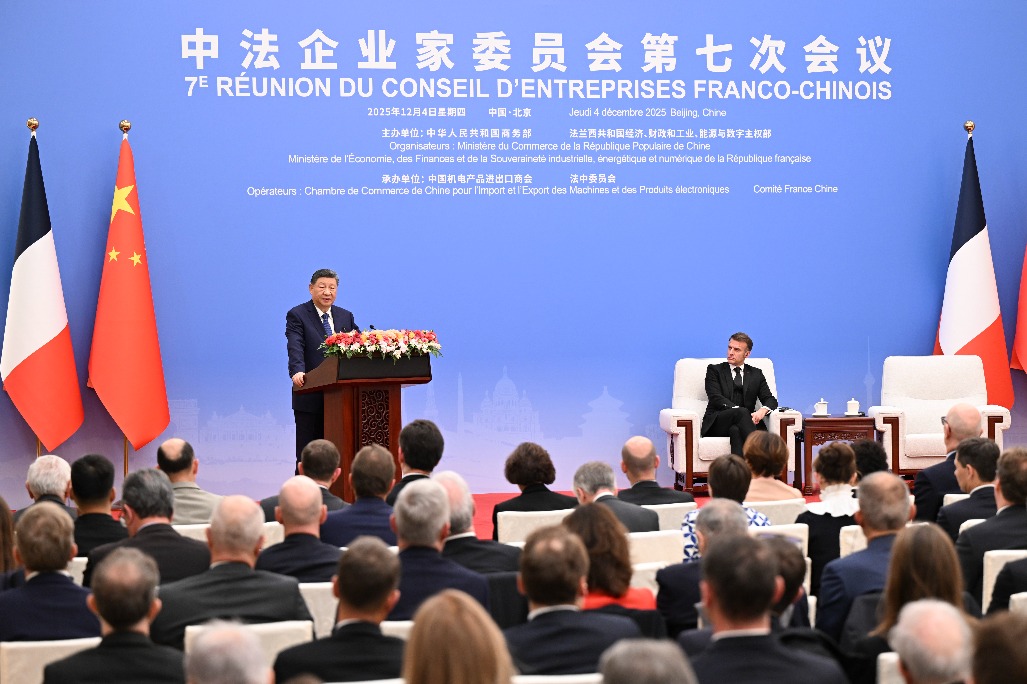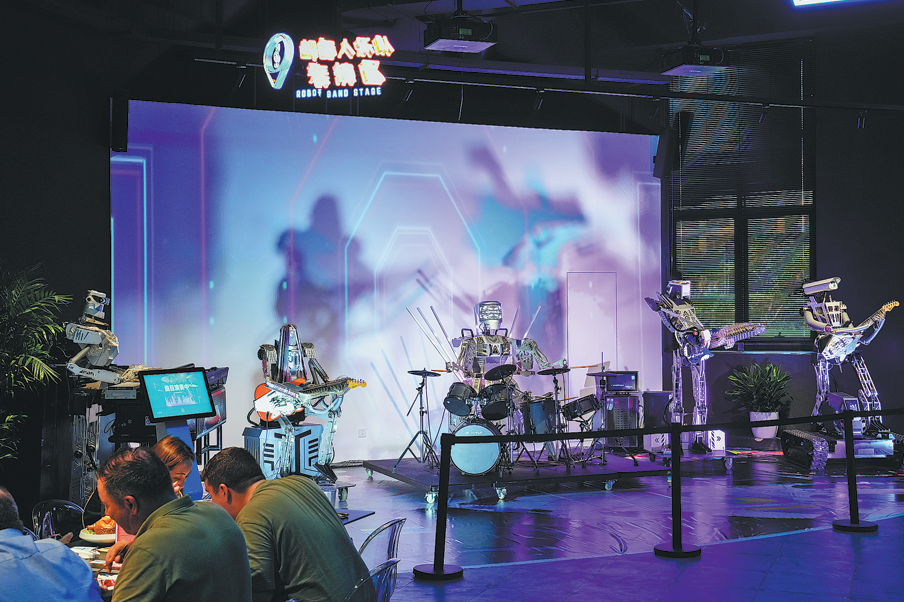Robot manufacturers shift focus to greater intelligence
Conference showcases nation's rapid advances in breakthrough tech

BEIJING — Robots that are not only able to run, dance and play soccer, but also sort parts on an assembly line, try their luck at a game of mahjong and even tickle the ivory were once fantasies confined to science fiction novels, but are now a reality that was unfolded at the recent World Robot Conference in Beijing.
The WRC 2025 showcased rapidly advancing embodied intelligence technology, with humanoid robots as the highlight, demonstrating significant progress achieved globally and particularly in China, while the event also served to illuminate a wide range of future commercial application scenarios.
Themed "Making Robots Smarter, Making Embodied Agents More Intelligent," the five-day conference that finished earlier this week featured forums, exhibitions, competitions and networking events — with over 200 robotics companies from around the world showcasing their latest innovations.
Exhibitors at the WRC showed off their latest humanoid robots along with other varieties such as wheeled robots, collaborative robots and quadruped or hexapod robotic dogs, as well as newly developed embodied intelligence models.
Unitree Robotics, based in East China's Hangzhou, Zhejiang province, brought its latest humanoid R1 and quadrupedal A2 automatons to the conference. A crowd favorite was a boxing match by two of the latest upgraded GI robots. The mechanical boxers punched and defended like real human fighters, while getting up to continue even after being knocked down.
Marketing manager at Unitree, Liu Jinda, said the sparring demonstration wasn't just for show. "During boxing, multiple joints need to coordinate with extremely fast reaction times. When subjected to external forces, the robots must quickly regain stability and balance. This practice provides valuable experience for developers to improve robotic performance."
In the exhibition area of Galaxea AI, visitors only needed to say "Please make the bed," and the company's new R1 Lite robot responded by completing the task in a randomly disordered bedroom all by itself.
Galaxea AI chief scientist Zhao Hang said the key to embodied intelligence robots lies in their "brain" — represented by the sophistication of their algorithms. R1 Lite's Vision-Language-Action model uses a single end-to-end architecture to achieve precise control from visual perception to its sophisticated joints, enabling it to perform highly complex, long-sequence tasks like making a bed.
At a conference forum, Ni Guangnan, an academician at the Chinese Academy of Engineering, emphasized that combining robots with AI requires elevating robotic intelligence through "brain-eye-action "coordinated systems — enabling automatons to see, understand and act in the real world.
Unitree CEO Wang Xingxing said that while current robotic hardware is generally sufficient, their AI capabilities still fall far short of industry needs, and developing sufficient embodied intelligence models will be the most critical task for the industry in the future.
China's innovations in embodied intelligence are powered by the robust development of its robotics industry. According to data released at the conference, the country's robotics industry generated nearly 240 billion yuan ($33.4 billion) in revenue in 2024.
In the first half, industrial robot production in China reached 370,000 units while service robot output hit 8.82 million units, representing year-on-year growth of 35.6 percent and 25.5 percent, respectively. China has also been the world's largest industrial robot application market for 12 consecutive years, with its share of the world's newly installed robots increasing from 51 percent in 2023 to 54 percent in 2024.
Rev Lebaredian, vice-president of Omniverse and simulation technology at Nvidia, said in a speech at a forum that China boasts the world's largest pool of top-tier graduates in computer science and AI, while holding a distinct advantage in physical-world tech development. This enables the country to produce robots that are both cost-effective and highly efficient — a capability unmatched by other countries.
Moreover, China possesses not only manufacturing prowess, but also the unique ability to deploy robots at scale and iterate rapidly. By deploying robots in real-world applications and collecting operational data, Chinese developers can continuously optimize robotic systems. This closed-loop improvement capability has become an essential requirement for robotics advancement, and China already enjoys this competitive edge, Lebaredian said.
The embodied intelligence sector, notably, is attracting not only AI innovators, but also traditional industrial robotics companies. At WRC 2025, established players like Siasun and Dobot, once focused on robotic arms and autonomous forklifts, deployed humanoid robots at their most visible displays. With decades of industrial application experience, they are injecting new momentum into the application of embodied intelligence technologies.
At the opening ceremony of the conference, the Chinese Institute of Electronics unveiled 10 most promising application scenarios for humanoid robots, such as automotive manufacturing, petrochemical production inspection, emergency response operations, home services and agricultural tasks.
The Beijing Humanoid Robot Innovation Center showcased the multi-agent and multitasking collaborative capabilities of embodied intelligent robots in industrial scenarios. Some of the robots are responsible for power inspection and others sort parts on assembly lines, while robotic arms in the inspection area automatically identify defective light bulbs.
Several that showcased products at the expo have achieved initial commercialization in the medical and eldercare sectors. For example, a six-legged robotic dog developed by Shanghai Jiao Tong University will provide assistance to vision impaired individuals such as serving as seeing-eye dogs at the upcoming 15th National Games in November, jointly hosted by Guangdong province, Macao and Hong Kong.
Longwood Valley MedTech, meanwhile, introduced its latest orthopedic surgical robot — which enables more precise, minimally invasive and safer surgical procedures, reducing surgery time from around three hours to just 30 minutes. It also minimizes blood loss, accelerates patient recovery, lowers the risk of postoperative complications and cuts medical costs.
Beijing AI-robotics Technology exhibited various wearable exoskeleton robots that can not only help paraplegic individuals stand and walk, but also assist the elderly with stair climbing.
Shuai Mei, the company's founder, said these robots detect both the user's walking intent and terrain conditions, and then use AI algorithms to adapt to the ground and gait in real time, thereby providing appropriate assistance. The company has sold around 1,000 units of its medical and eldercare products, which are now in use in over 300 hospitals nationwide.
Wan Gang, president of the China Association for Science and Technology, said at the conference that China is intensifying its efforts in this cutting-edge and future-oriented industry to spur new consumption, cultivate emerging industries, create jobs, promote economic growth and improve people's lives.
Xinhua


Today's Top News
- Tokyo urged to specify its past commitments
- Cooperation conducive to steadying progress in China-France partnership: China Daily editorial
- Shenzhou XXI crew set for first extravehicular activities
- Xi, Macron attend China-France Business Council meeting
- China expected to prioritize boosting consumption and domestic demand in 2026, expert says
- Xi, Macron jointly meet press






























